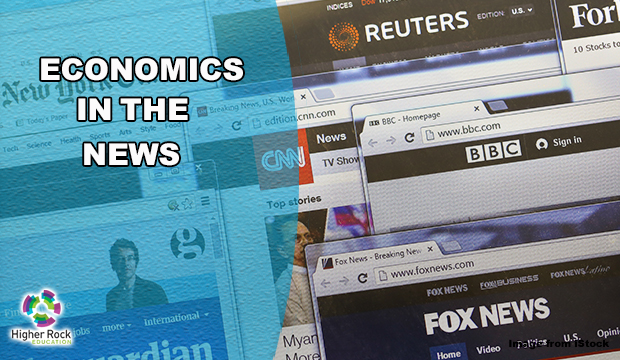Economics in the News – June 27-July 3, 2022
Economics impacts our lives every day. Below are some of the top storylines from this past week related to economics.
- Shockwaves were sent throughout college football, as the University of Southern California and University of California, Los Angeles announced their intentions to leave the PAC-12 Conference to join the Big Ten Conference. The two historic programs and rivals are set to join the Big Ten beginning in 2024-25. Those two schools, along with Rutgers University in New Jersey, provide the conference access to the two largest media markets in the country in New York City and Los Angeles.
The Big Ten has become a behemoth, along with the Southeastern Conference, since signing its latest media rights deal in 2017. That six-year deal brought in an average of $441.7 million per year in TV revenue, providing the 14 conference schools with an average of $49.2 million in 2019-20. By comparison, the PAC-12 distributed an average of $33.6 million to its 12 members that same year. With the Big Ten seeking a new TV deal for 2024 and beyond, by adding USC and UCLA to the Big Ten footprint many experts believe the Big Ten will receive more than $1 billion per year, allowing schools to enhance facilities, retain top coaches and improve travel. [The Los Angeles Times]
- The stock markets suffered their worst half of a year since 1970, as the second quarter of 2022 came to a close. Every sector besides energy is down for the year. Bonds are also in decline in 2022. Fear of a recession, reduced consumer spending, and the Federal Reserve’s recent increases of its benchmark interest rate to tame inflation have investors worried that corporate profits will fall.
After peaking in mid-January, the S&P 500 has dropped 21 percent over the last six months. It has declined in 10 of the past 12 weeks, drawing worries from companies considering a move to go public. Initial public offerings in the first half of 2022 are at their slowest pace since 2009.[The New York Times]
- Rising mortgage rates are decelerating the home-buying frenzy that has been a staple throughout the COVID-19 pandemic. The S&P CoreLogic Case-Shiller index shows that housing prices climbed at an annual rate of 20.4 percent in April, down from 20.6 percent in March.
Mortgage rates have nearly doubled since the beginning of 2022. The combination of increased rates and high prices are pricing out potential buyers and slowing the housing markets in some areas. Price growth continues to accelerate in some cities, most notably in the south in areas such as Atlanta, Dallas and Charlotte, N.C. [Bloomberg]
- The smartphone revolution kicked off in earnest 15 years ago. The original iPhone went on sale to the public on June 29, 2007. Since then, the iPhone has changed the way that society communicates and looks at our phones.
The iPhone changed the dynamic between phone manufacturers and wireless carriers. Since the original iPhone, smartphones have become smarter, faster and a more critical part of society. It’s also played a significant role with the advent of industries such as social media, allowing users access on their mobile device. [Pittsburgh Tribune-Review]
- Three out of four Americans rely on cars to commute to work. But the price of buying a car is increasing. The average monthly car payment crossed a record-high $700 per month earlier this year, according to Cox Automotive/Moody’s Analytics. The average price of a new vehicle is more than $47,000. Of course, that doesn’t account for the insurance, maintenance and gas prices needed for the car as well. Used car buyers face rising prices as well, facing a 16.1 percent increase in prices compared to last year. By comparison, new car prices have increased 12.6 percent in the last year.
The main reason cars have become more expensive is due to a chip shortage that began during the COVID-19 pandemic. When car sales declined, auto manufacturers slashed orders for chips. Chip production shifted to other electronics, such as laptops, iPads, TVs, etc. With a limited supply of chips, automakers decided to build larger, more expensive cars [NPR]
